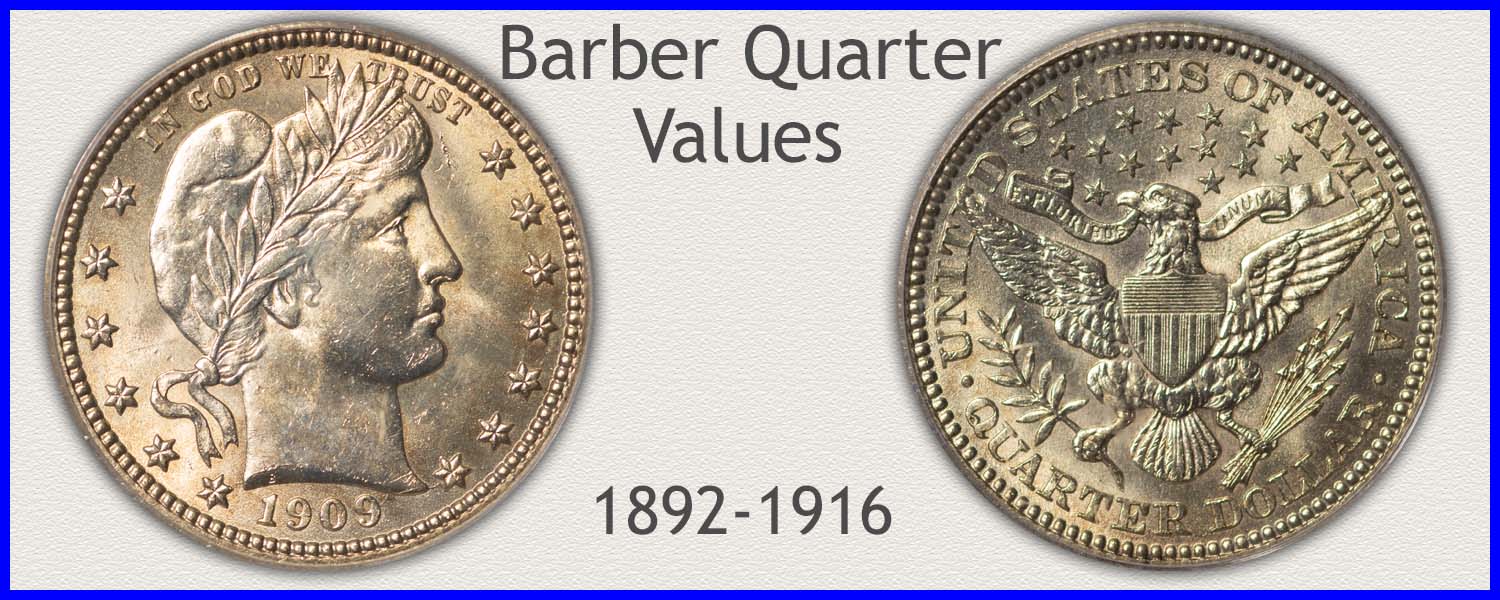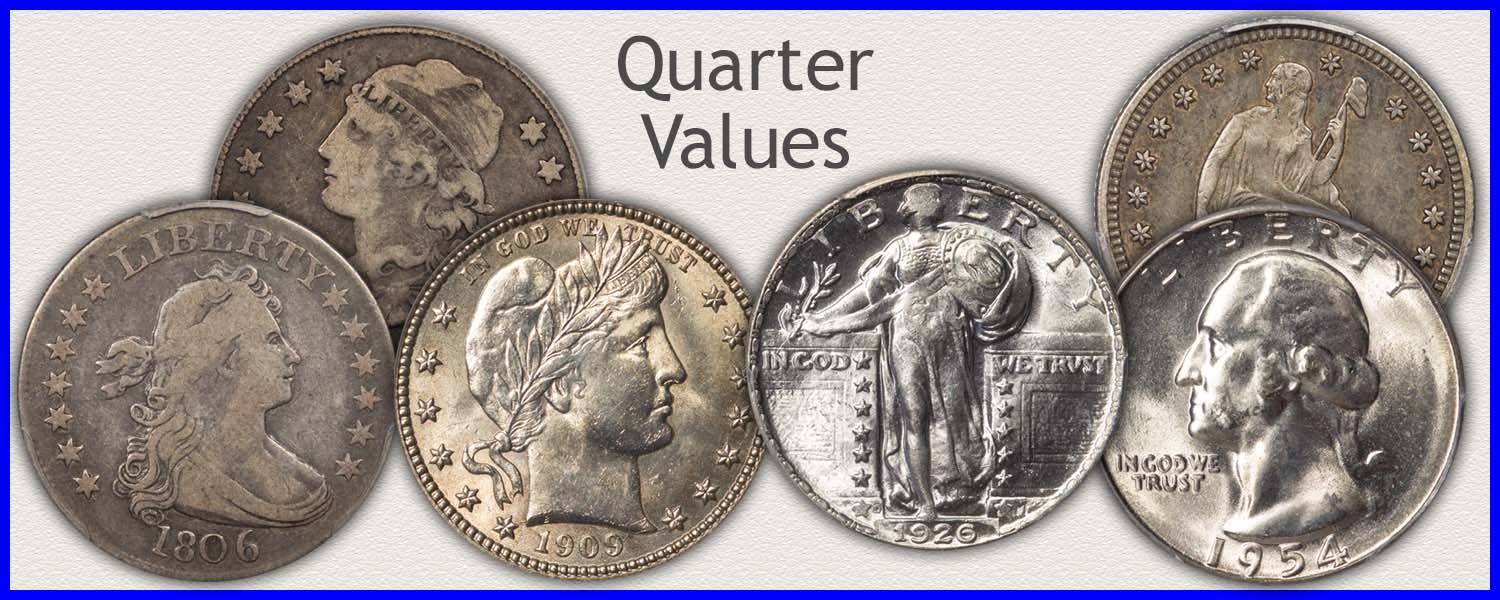Coin Values Moving with Precious Metals: Up-Dated 12/29/2025: Gold $4449 | Silver $75.46
1915 Quarter Value
The current range of 1915 quarter value is narrowed down using a step-by-step process.
How much these Barber quarters are worth depends on the specific date and mintmark combination, as shown on the chart. Also, it's important to judge the condition of the coin to find the ones with higher premiums.
When identifying the quarters as possible collectible quality, silver content value then becomes a basis and nice starting point. Begin by determining a precise date and mint, then compare to a series of grading images to determine condition.
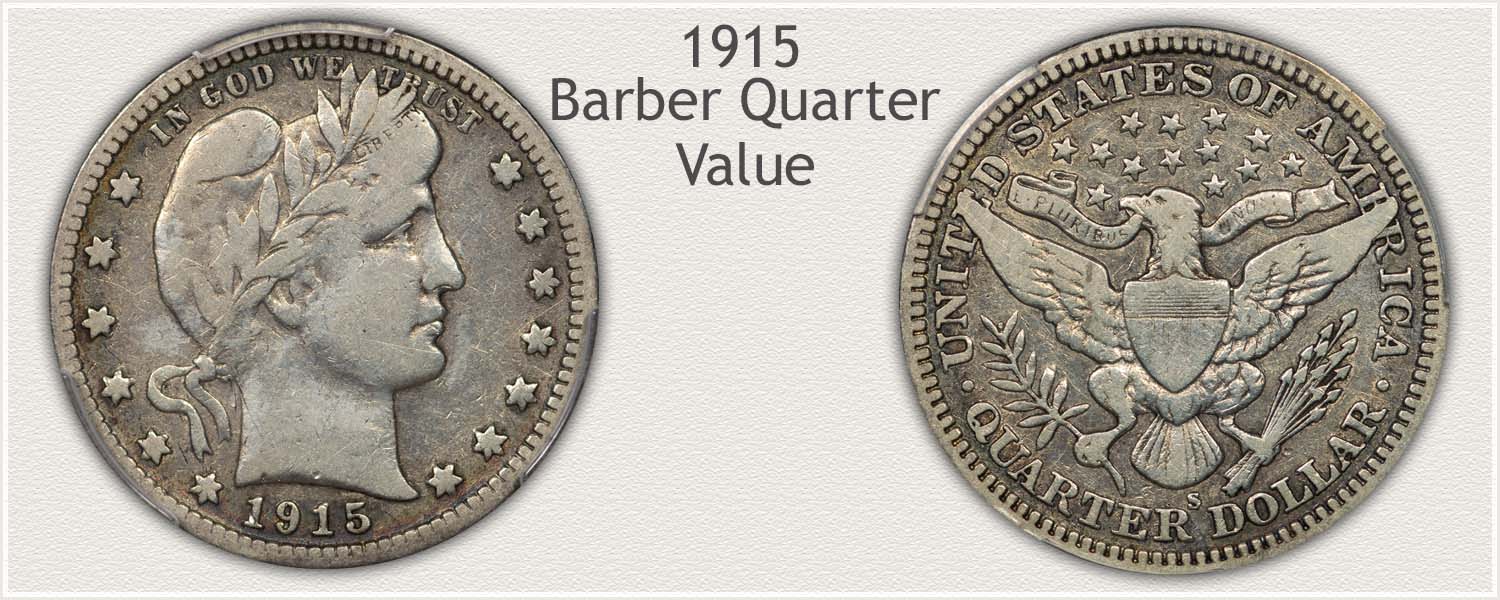
Steps Leading to Value:
- Step 1: Date and Mintmark Variety - Identifying scarce mint varieties requires a detailed examination. Mintmarks identify the particular mint that struck the 1915 quarter.
- Step 2: Grading Condition - Among the most popular coins to collectors are those in a high state of preservation. A grading system identifies its condition and places it in one of several categories shown on the chart.
- Step 3: Special Qualities - Once recognized, special qualities are recorded to develop an accurate description of your coins.
| 1915 Quarter Value | ||||
|---|---|---|---|---|
| Condition of Coin | ||||
| Date | Good | Fine | Extremely Fine | Mint State |
| Barber Quarter Values Updated | 12/29/2025 | |||
| 1915 | $18.21 | $20 | $62 | $206 |
| 1915 D | $18.21 | $16 | $54 | $196 |
| 1915 S | $23 | $63 | $133 | $243 |
Listed is a range a collector would sell Barber quarters to a dealer. Use as a guide.
Step 1: | Date and Mintmark Combination is Identified
Mint Varieties Issues of 1915 Quarters
Identification of the mint that struck the coin, together with the date of these Barber quarters, is a crucial first step in determining value. Since these quarters were produced by three different mints, mintmarks were used to identify their production.
Each entry in the chart includes the date and mint and is valued separately. The mintmark and its location are identified with images.
1915-S Barber Quarter
"S" Mintmark on Reverse: San Francisco Mint Struck the Coin
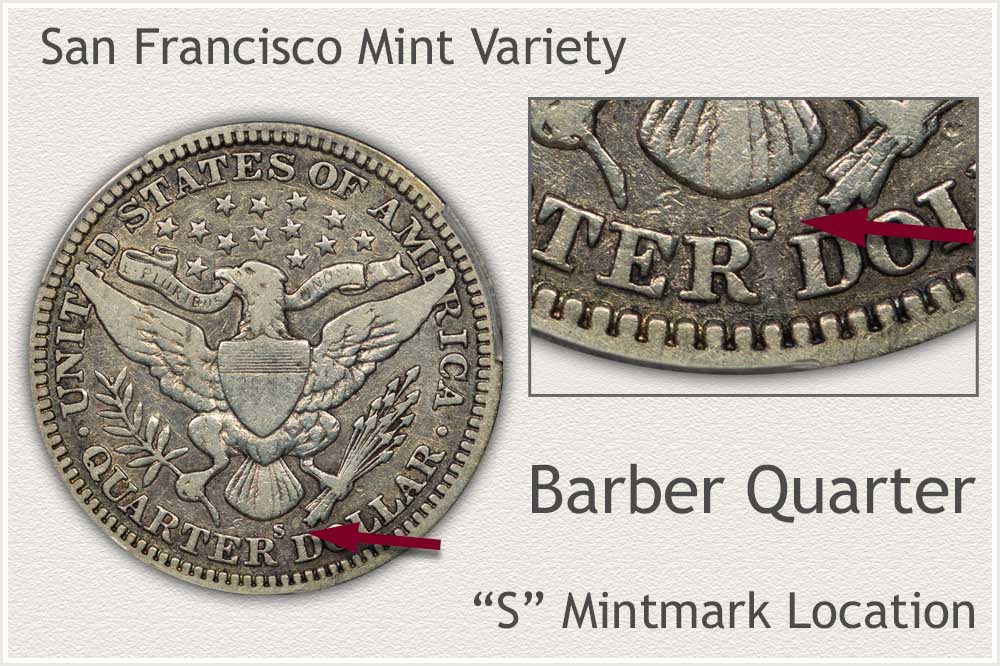
San Francisco 1915 quarters are the year's most scarce mint issue. Only 704,000 pieces from the mint were added to the production of quarters in the year. As time has passed, these low mintage quarters have grown increasingly scarce.
Any United States coin having a mintage of less than one million attracts the interest of collectors. All states of preservation are valued highly. It is popular with new collectors to collect well circulated pieces. For advanced Barber quarter collectors, finding a lightly circulated or nicer example is often difficult.
The "S" mintmark that the mint used on all of its production identifies San Francisco coins. An "S" mark is seen above the lettering "Quarter Dollar" on the reverse.
1915-D Barber Quarter
"D" Mintmark on Reverse: Denver Mint Struck the Coin
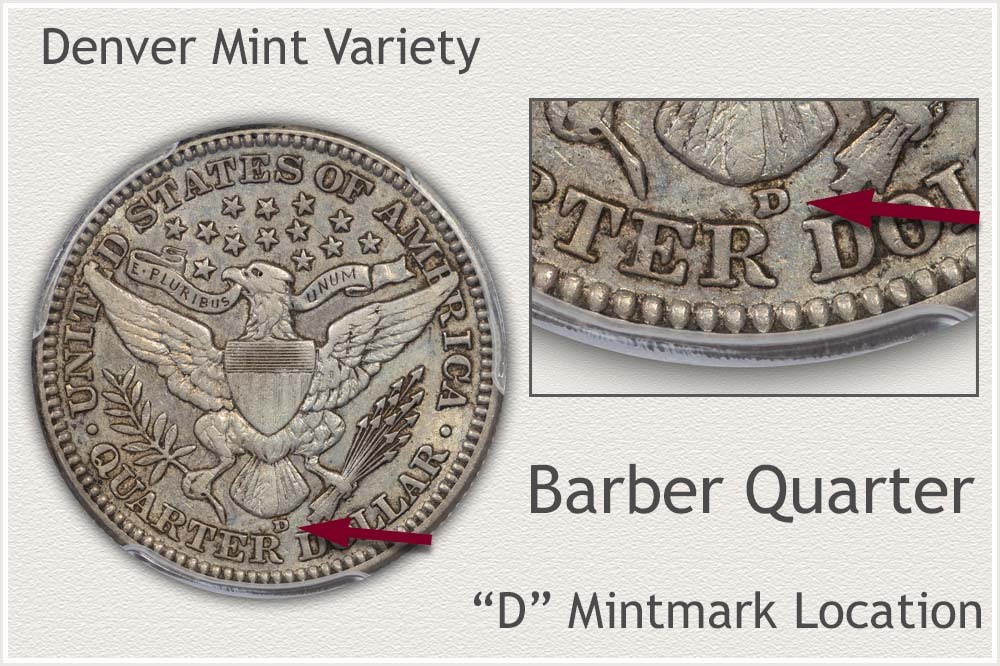
Large numbers of quarters were minted at Denver in 1915. Mint records list the total at 3,694,000 produced with many available today. Heavily worn pieces supply the silver market, these are worth their silver content. Nice, detailed examples are less available and awarded a large collectible premium. Confirming the date/mint combination then leads to the next step, judging the condition of your coin. With these factors a narrow value range is determined.
Denver placed a "D" mintmark on all Barber quarters the mint produced. Turn to the reverse of the quarter, examine the area above the lettering of OUARTER DOLLAR. The large "D" is the mintmark and identifies the Denver variety.
1915 Barber Quarter
No Mintmark on Reverse: Philadelphia Mint Struck the Coin
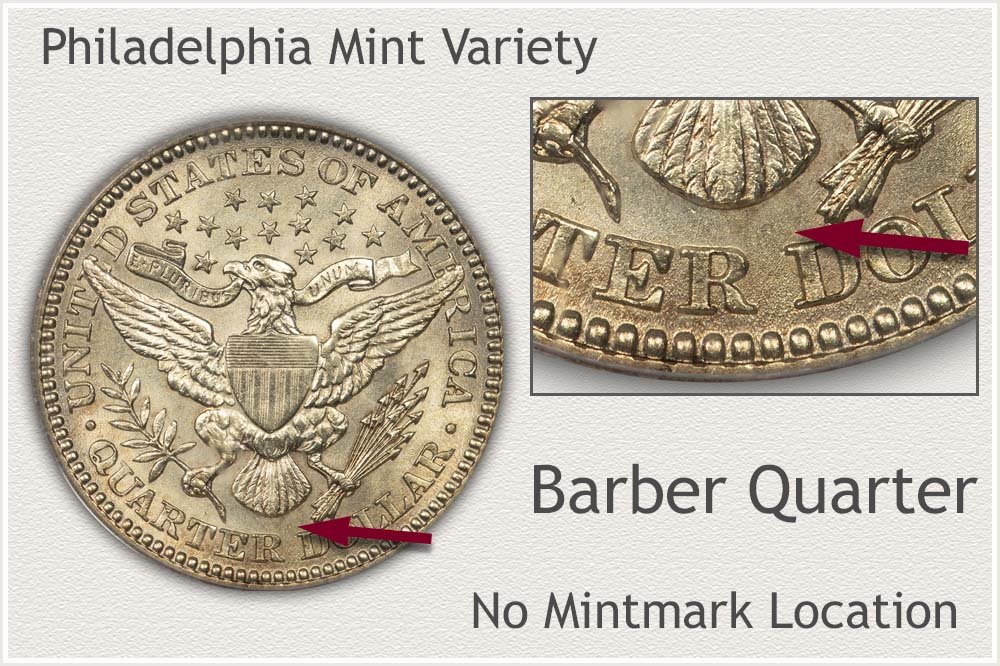
Only the Philadelphia mint struck quarters each year of the series, out of the four mints that produced Barber quarters. With its very low number of coins struck, 3.4 million struck, a 1915 quarter is an appealing coin to all collectors. Their demand for the coin plus high silver value is evident by the strong premiums on the value chart.
It is still possible to find heavily worn examples, although it is quite difficult to locate pieces of higher grade. Scarcity of higher, collector quality coins results in significant premiums, as shown in the chart.
Coins struck at the Philadelphia mint are identified by their lack of a mintmark. During the Barber quarter series, the mint did not use a mintmark on any of the coins it produced. Turning to the reverse of the coin, above the "R" and "D" of "Quarter Dollar", there is an empty space.
Step 2: | Recognize an Accurate Condition by Grading
Confirm an Accurate 1915 Quarter Value
Vintage and old coins often see a significant gain in value as their condition improves. A process of grading coins involves comparing them to standards that represent degrees of wear. Subtle details in both the high relief and low relief areas are studied to identify how much metal has been lost due to wear.
Compare your coin using the images and descriptions, and you'll soon identify a narrow condition range. Identifying the key design features that distinguish one grade from the next is helped with the use of a magnifying lens. When viewed under a single light source, the light contrast across the surface highlights a coin's finer details. Begin with the Mint State grade example, a coin with complete design detail.
Mint State Grade
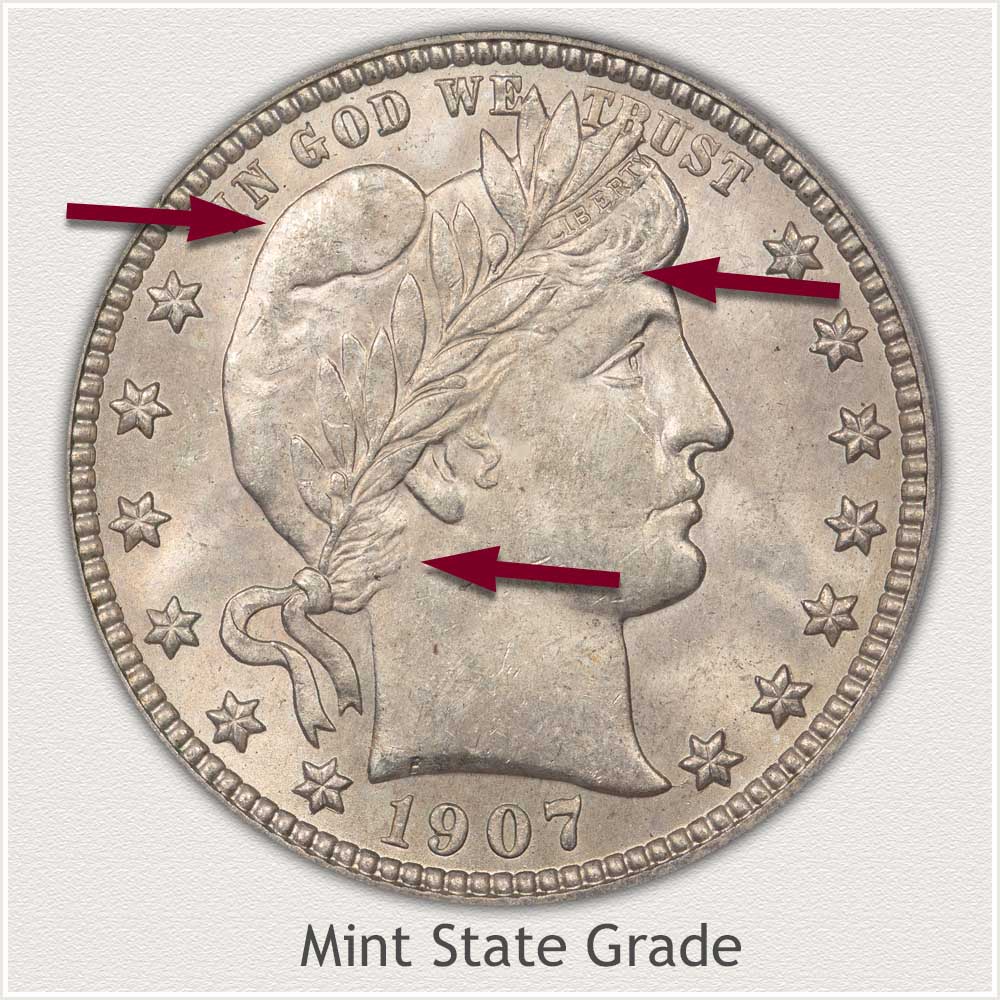
Mint State: Mint State quarters have no wear to their surfaces. These quarters have a noticeable brilliance when they are first minted because of the surface texture of fine lines. When a mint state coin is tilted and rotated under a light, this texture reflects light in a radiant shine.
To ensure that this delicate luster is complete, high areas of the design are examined for wear, smoothing, dulling, and flattening. When the coin is in circulation, one area that quickly dulls and smooths is Liberty's cap. Examine along the upper edge of the cap, intact metal has not been smoothed; the brilliance is still present. A worn silver surface has a grayish tone as opposed to an original minted surface with a bright shine.
Additionally, Liberty's hair above the forehead clearly shows fine lines with no flatness or merging. Design features on the example quarter show no signs of flattening due to wear in this area of very high relief.
Extremely Fine Grade
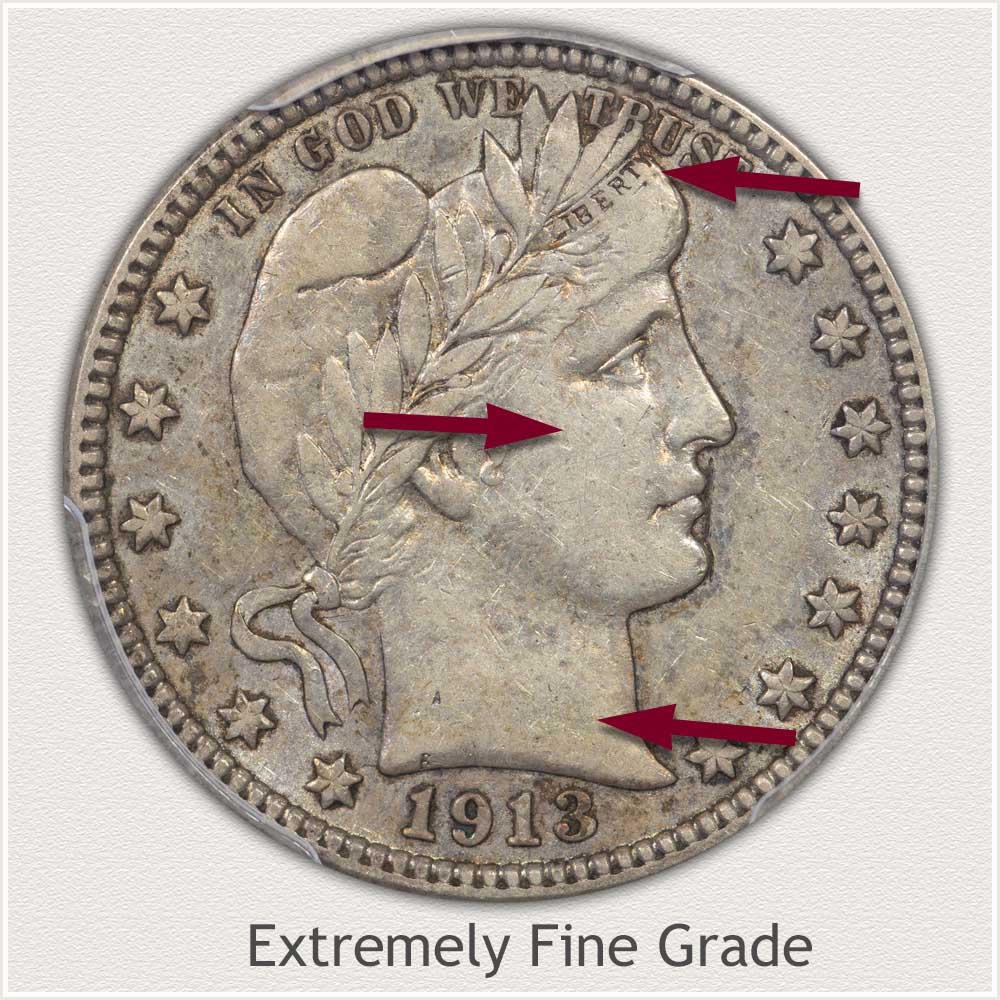
Extremely Fine: As a series, Barber quarters, are now considered a very old coin. Uncommon and highly collectible are examples with only a slight amount of wear. Extremely Fine grade coins have wear limited to only high relief areas.
In order to determine how much wear has taken place and loss of detail, specific areas of the design prone to early wear are examined. Note, Liberty has a very high-profile headband. This area is the first to show signs of wear, and the condition of the lettering and band are used to determine how much metal has been worn. A strong lettering of "LIBERTY" across the band places the example well within the grade. All letters are full, and most of the lower edge of the band is still clearly visible.
There is a slight smoothing of Liberty's face and neck, with the contours of her cheek appearing rounded. Overall, the design of the coin is well detailed, with the majority of fine lines in the hair near the ribbon, knot, and wreath leaves visible. To ensure that these coins maintain their high level of preservation, only handle them by their edges.
Fine Grade
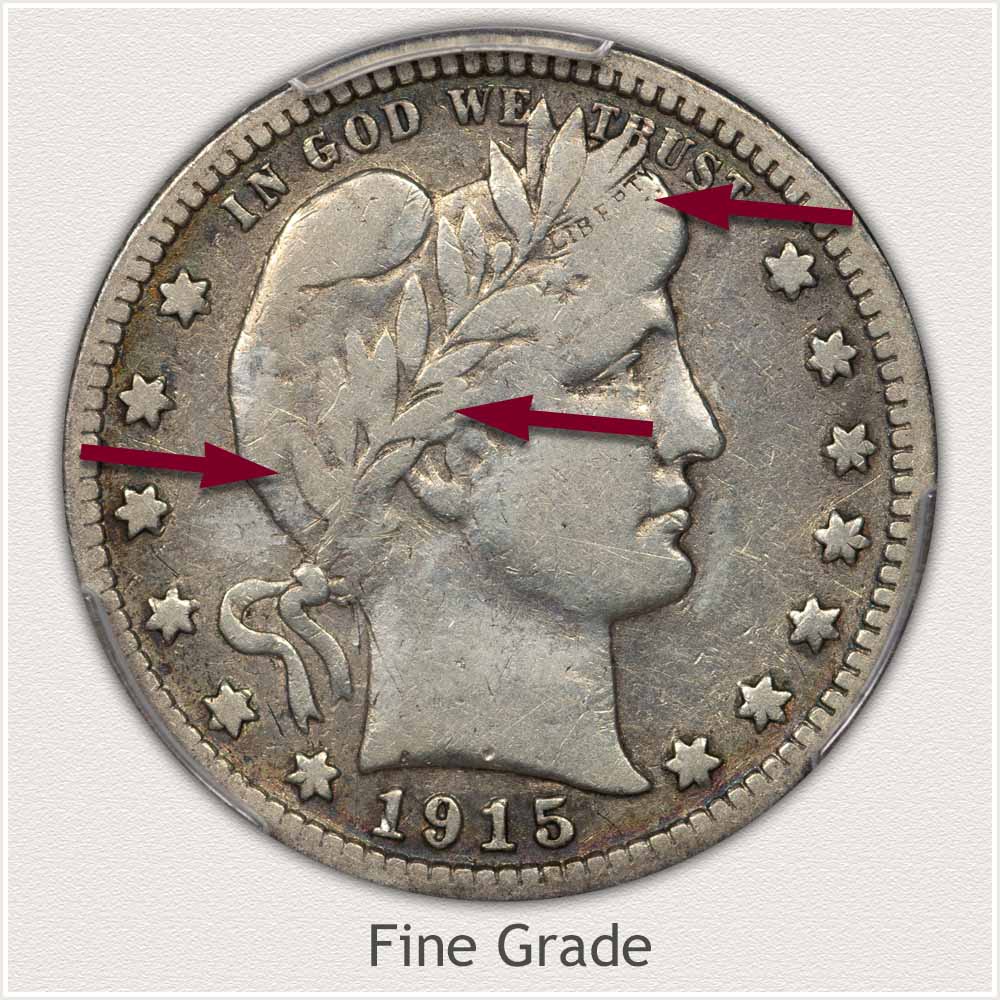
Fine Grade: An attractively detailed Barber quarter is a somewhat rare coin. This collectible's general condition is summed up as displaying only moderate wear. Fine is the grade awarded to a coin when the majority of its details are visible alongside small areas of flatness.
Within Liberty's hair, the Laurel wreath is an important feature when examining condition. Tied with a ribbon and knotted at its end, the wreath must show a strong outline of the upper row of leaves. Confirming the Fine grade and moderate wear, the leaves are now fully flat and smooth due to wear, although they are still well outlined. Many of the leaves in the lower row are indistinct and blended with Liberty's hair. Different wear patterns between the leaf rows is a feature indicating moderate wear while keeping the condition in the Fine grade range.
Overall, despite being worn and exhibiting areas of flattened metal, these coins are an appealing quality to collectors. Nice examples are in high demand when found with soft silver-gray color and toning highlighting their features.
Good Grade
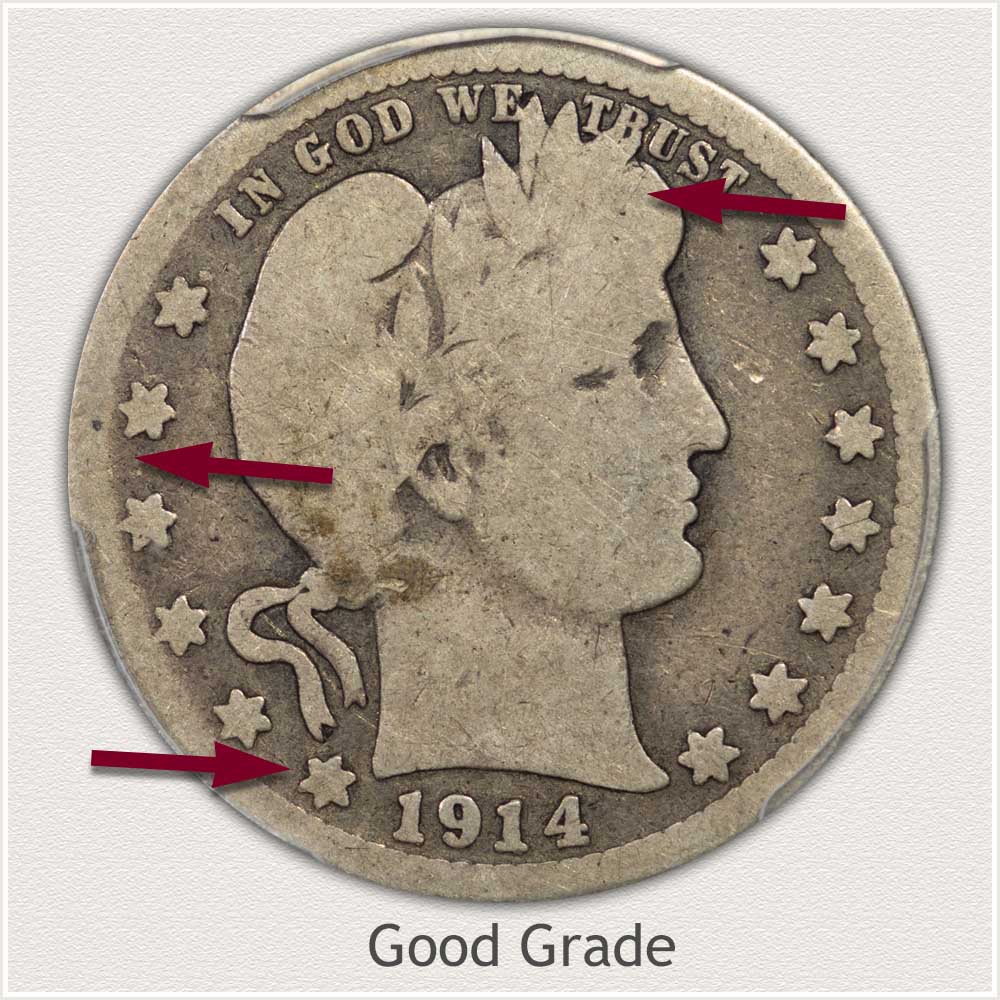
Good Grade: A Good Grade quarter is defined by a complete outline of Liberty and a lack of significant central details.
All of the fine details to the headband, including the once defined hair line that ran over Liberty's eye, have been removed by wear. There does remain small details visible to the cap at the back of her head, as well as the ends of leaves along the top of the portrait are complete. An important feature of the coin is the entire portrait is fully outlined, with no fading into the coin's fields.
A complete rim is one of the factors that goes into judging and identifying the Good grade. In addition to the clearly visible date and the raised stars, the coin displays a nice impression. On the example quarter, there are no large marks that draw attention, and remaining details are bold.
How to Video: Grading Barber Quarters
Carefully evaluate the condition of these vintage quarters by watching the video and using the additional images provided. Narrow the value range on the chart.
Video, Images and Descriptions | Grading Barber Quarters
Step 3: | Special Qualities | Important Elements to Value are Recorded
Insure Identifying Full Barber Quarter Value
Current values of your Barber quarters need organized record keeping. Up-dating information helps in a proper value judgment.
Print the Coin Values Worksheet to start a reference to Barber Quarters.
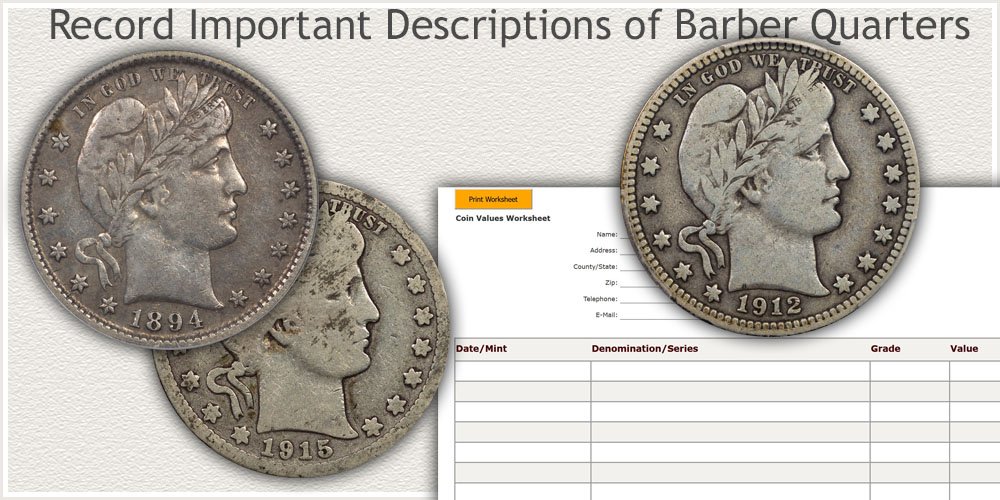
Firstly, date the worksheet in order to have a starting point to current values. Quarters worth primarily based on silver price, see values changing often. In the second era of the Barber series; 1900 to 1916 many minimum values are influenced by up and down silver prices.
Key factor to value is the Date/Mint column. A record of an accurate date and mint variety of these quarters finds its exact place on value charts. Collectors identify each coin starting with Date and Mint.
The column; Denomination/Series records quarters as 25C and Barber noting the series for accuracy. As example: in 1916, quarters spanned both the Barber and Standing Liberty series. As information is gained, it becomes part of the description.
Grade is the subjective column on the worksheet. Here your judgment of condition impacts the value listing. A fair assessment of condition tending towards conservative, helps narrow the value range.
In the Value column, these listings become the basis for the extent of your holdings and future decisions. Additional study of higher value coins is also noted.
Completing and recording the key elements of value achieves a proper evaluation. A total of the collection is quickly determined. Additionally, a place to hold information aids in deciding future plans.
Barber quarters are divided into two major value categories. Collectible quality with premium values above silver worth. Second are those in the minimum range, moving with the price of silver. Extra care and inspection of the special quality coins is easily recognized. Print additional sheets as needed to continue with the rest of your holdings.
References
U.S. Mint. 1916 U.S. Mint Annual Report.
https://nnp.wustl.edu/library/book/514129
U.S. Mint. Catalogue of Coins of the United States.
https://nnp.wustl.edu/library/book/554591
Coin Values | CoinStudy Articles
Date by Date
In Depth Barber Quarter Values
1892 to 1916
Barber Quarter Value | Strong Demand by Collectors
Collectors seek 1915 quarters as part of the long running Barber design series. Full listing of the many date and mint combinations are found on the value chart. Mintmark images and grading images identify and judge these old quarters finding an accurate value of each.
Quarter Values | Scarce Series and Designs
Many appealing designs are part of the quarter denomination of U.S. coinage. Barber quarters were minted long after the first quarter in 1796. Bust and Seated quarters are the very early issues and highly valued. Identify your old quarter with images and links to the series.
Old Coin Value | Images Identify Varieties
Quarters along with the other denominations of U.S. coinage were minted in many different designs over the years. Matching your coin to images identifies the correct design variety. Links to each series including value charts, and coverage of how to place a value on old coins.
Safe Coin Storage | Recommendations
High valued coins when properly stored are protected from handling, further damage, and remain in the same condition when collected. Recommended are products available to collectors to house both single coins and multiple coins in groups.
Popular Coin Series | Barber Quarters
Registry set collections give an insight to the numbers of serious collectors involved in the different series of U.S. coinage. Quarters in general, are a popular denomination to collect. Barber quarters are in demand by a solid group of collectors. Rankings of all major series are presented.
Barber quarters of the available issues in heavily worn grades have a strong value based on their silver content. Using images, identify U.S. silver coinage, calculate current worth, and reference dealer listings to find buyers of these silver coins.
★Coin Values Discovery finds 1915 Quarter Value and...
All U.S. coin values. Coins are valued on a scale depending on the series, date, and condition. These primary elements are part of a step-by-step process followed when judging old coins. Start the process by comparing to images of the different series of U.S. coins and links to each series and value charts.
